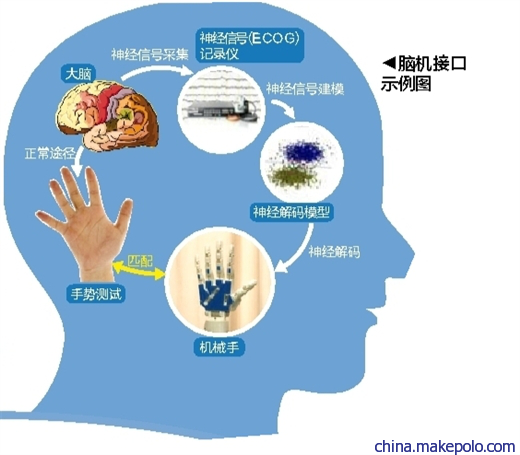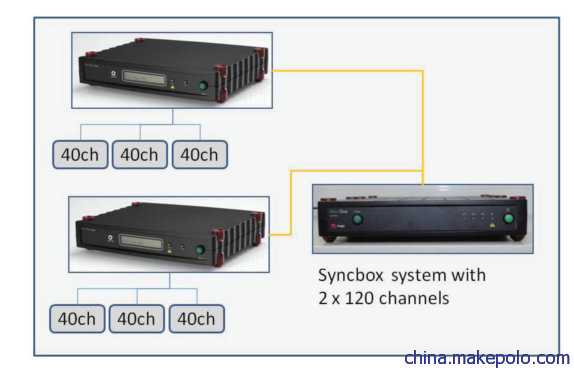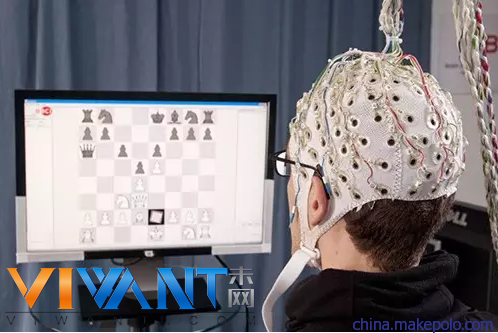
NeurOne BCI System脑机接口系统

NeurOne EEG/ERP系统是芬兰Mega公司开发的创新的生理监测解决方案,这个认知神经科学测量系统利用世界最新的数字信号处理技术的发展,目前是全世界性能最好的脑电系统,该系统提供了更准确、更纯净的信号、更高的采样率、模块化解决方案,更大的灵活性和可扩展性。NeurOne是一个通用系统,可以广泛应用于不同的神经科学和心理学应用中。
NeurOne可以与fMRI功能性核磁共振或者TMS经颅磁刺激器结合进行实验研究;NeurOne是专为与TMS经颅磁刺激器一起使用,有特殊还原技术在短延时情况下来消除磁制品影响。先进的头盒设计使两AC交流电和DC直流电信号可单独或同时,新的创新的Tesla放大器给NeurOne带来MRI兼容性。
NeurOne挑战传统的认知神经ERP实验室系统:
24Bit高分辨率
每通道最高可达80000Hz超高速采样率
高精度放大器技术
可升级为NeurOne Brainstorm系统,最高达1200导联

应用领域:
EEG/EP测量
ERP研究
EEG + TMS结合研究
EEG + fMRI结合研究
多通道EMG肌电图研究
群组研究(多达4人4视频摄像机完全同步)
其他神经科学的测量
其他心理测量
NeurOne简要技术参数:
4 x 40 通道 – 主机单元和放大器之间通过光纤连接
24-bit采样
 可选的可充电放大器电池(减少50/60 Hz工频干扰)
可选的可充电放大器电池(减少50/60 Hz工频干扰)

 AC / DC模式分别选择(按通道顺序)
AC / DC模式分别选择(按通道顺序)
Windows 8兼容的软件,可以导出其他数据格式
NeurOne系统特点:
EEG-TMS研究:
NeurOne系统可以和TMS(经颅磁刺激器)搭配使用。高动态输入范围(+/-430mV的直流电模式以及+/-86mV的交流电模式),较大的模拟带宽(直流输出3500HZ),让TMS保持较低的伪影,使得分析大脑活动的潜伏期更短。此外,TMS拥有硬件弱音功能以及在线伪影消除的软件功能。此外我们增加了EEG采样同步触发新功能。触发器由刺激系统软件发出(Presentation软件, Superlab软件, E-Prime软件),这些触发信号能够通过NeurOne主控器传到TMS设备上。NeurOne可以在持续的EEG采样信号中发出触发脉冲,产生更精确的TMS,减少伪影,更容易进行伪影去除。
EEG-MRI研究:
NeurOne Tesla 使得同时测量MRI 和 EEG 成为可能。利用 NeurOne Syncbox EEG 所获得的数据和MRI扫描是同步的(例如 4 或 10 MHz)。 高动态输入范围(+/- 430 mV的直流电模式和 +/-86 mV的交流电模式)结合模拟带宽(直流输出3500 Hz) ,使利用高梯度力度获得精确信号毫无风险。
EP & ERP 研究:
NeurOne系统可以实际处理任何诱发电位(EP)和事件相关电位(ERP)测量任务,因为其广泛的触发接口,大量测量通道,低噪声和高采样频率。
EMG 高分辨率多通道研究:
NeurOne系统有高达32通道的专用双极通道,推荐用于EMG。 通过利用参考通道,可用通道的数量还能进一步增加。
团体研究:
系统的模块化设计可以提供多达4人同时使用系统,并支持完全同步的摄影机。 若使用我们的Brainstorm技术 (Multi Syncbox),多达10个 NeurOne 硬件系统能一起同步,允许30个放大器同时工作–均由一台电脑记录。
神经系统科学和心理学测量:
你给出信号, NeurOne 就可以测量它。例如, ME6000的所有传感器都能和NeurOne连接在一起。 此外,我们还可以根据你的目的定制NeurOne系统。 快来索取报价并描述你的需求吧。
BCI 脑机接口应用:
我们有 BCI2000 可免费提供给NeurOne用户。SIMULINK驱动可在订单中选购。
影像:
视频组件包含支持HDMI输出(+麦克风输入同步)、USB3采集盒、MPEG-2编码器和VideoSync单元的摄像头,每隔10秒发送触发到NeurOne EEG。相同的触发被反馈到视频的音频轨迹以达到在整个记录过程中精确同步。
数据格式的通用性:
NeurOne 的数据格式与大多数 EEG 分析模式一致,包括Matlab, EEGLAB, BrainVision Analyzer 以及 BESA。
NeurOne用户请注意:
注意 – 仅用于科研,不用于诊断过程,设备或可用于非临床实验研究。
BCI vs. HCI


 系统扩展性
系统扩展性
NeurOne系统是一个多功能的工具,对于神经科学
心理应用。您可以自定义系统,
通过将其与其他设备/模块结合,如:
•测斜仪
•测角计-torsiometer
•心率感应器
•负载、拉力和压力传感器
•加速度传感器
•陀螺仪传感器
•GSR传感器
•肌电,心电放大器
•自定义模块和传感器
NeurOne Tesla 系统EEG+ fMRI结合研究给核磁共振领域带来了- 更快采样率、更高24位分辨率更高导联数,并且MRI数据同步采集。,使用NeurOne Brainstorm系统的Syncbox多参数同步技术,允许记录最高达1200导联电生理数据。
EEG脑电放大器参数:
· 40导、80导、256-512导脑电放大器,
· 核磁脑电放大器,兼容fMRI、TMS、fNIR等环境
· 每个Headbox 有32导单极导联
· 每个Headbox 有8导双极导联
· 每个Headbox 最多有8导High Level 导联
· 采样率:每导最高可达80,000 Hz
· 所有导联均同步采集信号,系统最大支持1200高导联
· 放大器采样率:20000 HZ/每通道(256-512导单人/30人团体1200导),
· 20000 HZ/每通道(80导),
· 40000 HZ/每通道(40导), 80000 HZ/每通道(20导)
· A/D Resolution:24 Bit
· 输入阻抗:>1 GOhms
· 共模抑制比(CMRR): Typically 106 dB
· 带宽(Bandwidth): Max. 0 ~ 3500Hz
· 低通滤波(最大值):DC (10000Hz) ; -3 dB(7000 Hz),
· 高通滤波(最小值): -3 dB(0.16 Hz),
· 噪声(Noise)(DC Mode):<0.8 μV RMS (0-200 Hz),
· <2.0 μV RMS (DC-3500 Hz)
· 输入范围(Full Scale Input Range)(DC Mode):± 430 mV
· 系统增益(System Gain)(DC Mode):10
· 灵敏度(Sensitivity)(DC Mode): 51 nV/bit
· 噪声(Noise)(AC Mode):<0.6 μV RMS (0.16-200 Hz),
· < 1.5 μV RMS (0.16-3500 Hz)
· 输入范围(Full Scale Input Range)(AC Mode):± 4.3 mV
· 系统增益(System Gain)(AC Mode): 50
· 灵敏度(Sensitivity)(AC Mode): 0.51 nV/bit
· 数字化(TTL)输入: 8 Bit非隔离输入触发,2个隔离输入/输出线2 isolated trigger in/out lines, 8 bit unisolated trigger in
· High Level 输入范围: ± 5V or ± 10V
· 阻抗: 1 kΩ to 50 kΩ
· Headbox 体积(H x W x D): 20 x 7 x 16 (40 channels),
· Headbox 重量: 0.680 kg
· Main unit体积(H x W x D):33×12×27 cm,
· Main unit重量:3.6
· 安全规范:EN 60601-1,EN 60601-1-1,EN 60601-1-2
· EN60601-1-4,EN60601-2-26
芬兰Mega公司
 津发公司是芬兰Mega公司NeurOne EEG/ERP系统中国大陆地区独家总代理商,负责大陆地区的售前售后支持及技术服务、学术交流等活动。
津发公司是芬兰Mega公司NeurOne EEG/ERP系统中国大陆地区独家总代理商,负责大陆地区的售前售后支持及技术服务、学术交流等活动。
Mega是芬兰的高技术公司, 自1983年以来专攻生物信号的测量,有30年开发专业信号监测设备的经验,特别致力于这项技术在神经学、康复、职业健康和运动医学领域的应用。公司已经开发了一种集成且可移动便携的技术用以在实验室及户外现场研究条件下在皮肤表面无创式检测肌肉的活动能力。
芬兰Mega公司通过了ISO9001和ISO 13485认证。芬兰Mega公司生产的所有产品均已获得以下国际专利US5881731: US6289894: US6264582: FI98045。
生产质量和产品质量是Mega公司最关心的,因此NeurOne产品不仅在欧洲通过了严格的CE认证、获得CE标志、并且遵守安全规范:EN 60601-1,EN 60601-1-1,EN 60601-1-2、EN60601-1-4,EN60601-2-26等。
已经通过世界广泛的经销商网络在分布于全球二十余个国家的代理商进行销售、市场和客户服务。在日本、美国和欧洲与一些大学的研究实验室保持密集的合作并获取客户的直接反馈,使Mega公司保持持续的发展成为可能。
部分客户名单
REFERENCES - NEURONE EEG/ERP OR NEURONE TESLA:
AUSTRALIA:
QIMR Berghofer Medical Research Institute (NeurOne Tesla MRI 80) – Dr. Michael Breakspear
NICTA, Canberra (NeurOne 40)
BELGIUM
Université Catholique Louvain - Julie Duqué (NeurOne Tesla 80)
CHINA:
Beijing Sports University (NeurOne 160)
China Institute of Industrial Relations (NeurOne Tesla 80)
Donghua University (Neurone Tesla 80)
Institute of Acupuncture and Moxibustion, China Academy of Chinese Medical Sciences, Beijing – prof. GJ. Wang (NeurOne 40)
Huazhong University of Science and Technology, Wuhan (NeurOne 80)
National Police University of China, Wuhan (2 x NeurOne Tesla 40)
Tianjin Medical University (NeurOne 80)
Tianjin University (NeurOne 40)
Xi’an University (NeurOne 80)
Zhejiang University of Finance and Economics (2 x NeurOne Tesla 40)
DENMARK:
Danish Research Centre for Magnetic Resonance , Center for Functional and Diagnostic Imaging and Research - Hartwig R. Siebner / Axel Thielscher (NeurOne Tesla MRI 80)
FINLAND:
Aalto University, Center of Advanced Magnetic Imaging – Dr. Juha Silvanto (NeurOne 80)
GE Healthcare Finland – Patient Care Solutions (2 x NeurOne 40)
Finnish Institute of Occupational Health – Brain at Work Group (2 x NeurOne 40)
University of Jyväskylä – prof. Paavo Leppänen (2 x NeurOne 160)
Tampere University of Technology – prof. Tarmo Lipping (NeurOne 40)
University of Oulu – Dr. Jukka Kortelainen (NeurOne Tesla 40)
University of Oulu - prof. Timo Järvilehto (NeurOne 40)
Tampere University hospital – Dr. Joel Hasan (NeurOne Tesla MRI 80)
University of Turku - prof. Pirjo Korpilahti (NeurOne Tesla MRI 80)
University of Turku - prof. Harry Scheinin (NeurOne Tesla MRI 80)
VTT Technical Research Centre of Finland – Dr. Johanna Närväinen (NeurOne 80)
GERMANY:
Max-Planck-Institute for Human Cognitive and Brain Sciences, Dr. Vadim V. Nikulin (NeurOne Tesla 80)
Leibniz Research Centre for Working Environment and Human Factors, Dortmund – Prof. Michael Nitsche (3 x NeurOne Tesla MRI 80)
Leibniz Research Centre for Working Environment and Human Factors, Dortmund – Prof. Edmund Wascher (1 x NeurOne Tesla 80)
University of Freiburg – Dr. Tobias Pistohl (NeurOne Tesla 160)
University of Freiburg – Dr. Tonio Ball (2 x NeurOne Tesla 240 – can be operated as Tesla 480 channels)
University of Tübingen – Dr. Markus Siegel (2 x NeurOne 80)
University Hospital of Tübingen – Prof. Ulf Ziemann / Dr. Christoph Zrenner (2 x NeurOne Tesla 80, 1 x NeurOne Tesla MRI 160, 1 x NeurOne Tesla 80)
INDIA:
National Institute of Mental Health and Neuro Sciences, Dept of Speech Pathology and Audiology - Prof. M. Jayaram (Neurone 80)
SWEDEN:
Uppsala University – Dr. Per Alm (NeurOne Tesla 80)
TURKEY:
Koc University School of Medicine - Prof. Pekcan Ungan (NeurOne Tesla 40)
USA:
Rehabilitation Institute of Chicago – Dr. Tommi Raij (NeurOne Tesla MRI 80)
National Institutes of Health – NINDS/Bethesda – Mark Hallet (NeurOne Tesla TMS 80)
 部分文章列表
部分文章列表PUBLICATIONS USING NEURONE EEG/ERP OR NEURONE TESLA :
1. A platform for realtime processing of biosignals for monitoring purposes. PITKÄNEN, PAAVO. Master of Science Thesis. Tampere University of Technology. May 2012. In Finnish
2. A New Platform for Realtime BCI Applications. Paavo Pitkänen1,2, Jukka Kinnunen2, Tarmo Lipping1 (IEEE, Senior Member). 1 Tampere University Of Technology, 2 Mega Electronics Ltd. Poster at Berlin BCI meeting 2012
3. Visual ERP P3 amplitude and latency in standalone and embedded visual processing task. Conf Proc IEEE Eng Med Biol Soc. 2011;2011:781-4. doi: 10.1109/IEMBS.2011.6090179. Korpela J, Huotilainen M. Brain Work Research Centre, Finnish Institute of Occupational Health, Helsinki, Finland. jussi.korpela@ttl.fi
4. The effect of automatic blink correction on auditory evoked potentials. Korpela, J. ; Brain Work Res. Centre, Finnish Inst. of Occupational Health, Helsinki, Finland ; Vigario, R. ; Huotilainen, M. 10.1109/EMBC.2012.6346009
5. Breakfast high in whey protein or carbohydrates improves coping with workload in healthy subjects. Nora Sihvola a1, Riitta Korpela a1, Andreas Henelius a2, Anu Holm a2 a3, Minna Huotilainen a2, Kiti Müller a2, Tuija Poussa a4, Kati Pettersson a2, Anu Turpeinen a5 and Katri Peuhkuri a1 c1. a1 Institute of Biomedicine, Medical Nutrition Physiology, Pharmacology, University of Helsinki, PO Box 63, Helsinki FIN-00014, Finland. a2 Finnish Institute of Occupational Health, Brain and Technology Team, Topeliuksenkatu 41 aA, Helsinki FIN-00250, Finland. a3 Department of Clinical Neurophysiology, Hospital District of Satakunta, Sairaalantie 3, Pori FIN-28500, Finland a4 Stat-Consulting, Vahverokatu 6, Nokia FIN-37130, Finland a5 Valio Limited, PO Box 30, VALIO, Helsinki FIN-00039, Finland British Journal of Nutrition, 2013
6. Pilot Study of Acupuncture Point Laterality: Evidence from Heart Rate Variability. Guangjun Wang, Yuying Tian, Shuyong Jia,Wenting Zhou, and Weibo Zhang.
Institute of Acupuncture and Moxibustion, China Academy of Chinese Medical Sciences, 16 Dongzhimennei, Nanxiaojie, Dongchen District, Beijing 100700, China Evidence-Based Complementary and Alternative Medicine. Volume 2013 (2013), Article ID 476064, 7 pages /ecam/aip/476064/
7. Algorithm for automatic analysis of electro-oculographic data.
Kati Pettersson1*, Sharman Jagadeesan1, Kristian Lukander1, Andreas Henelius1, Edward Hæggström2 and Kiti Müller1
1Brain Work Research Center, Finnish Institute of Occupational Health, Topeliuksenkatu 41aA, Helsinki 00250, Finland.
2Electronics Research Laboratory, Department of Physics, University of Helsinki, P. O. Box 64, Gustaf Hällströmin katu 2, Helsinki FIN-00014, Finland.
BioMedical Engineering OnLine 2013 12:110.
8. Brain-state dependent brain stimulation: Real-time EEG alpha band analysis using sliding window FFT phase progression extrapolation to trigger an alpha phase locked TMS pulse with 1 millisecond accuracy.
Christoph Zrenner, Johannes Tünnerhoff , Carl Zipser, Florian Müller-Dahlhaus , Ulf Ziemann
Center for Neurology, Tübingen University, Hoppe-Seyler-Str. 3, 72076 Tübingen, Germany
Brain Stimulation: Basic, Translational, and Clinical Research in Neuromodulation: Volume 8, Issue 2, A1-A10, 169-438
9. Behavioral and electrophysiological evidence for fast emergence of visual consciousness.
Henry Railo1,2,3,*, Antti Revonsuo1,2,3,4 and Mika Koivisto1,2,3
1Department of Psychology, University of Turku, 20014, Finland; 2Centre for Cognitive Neuroscience, University of Turku, 20014, Finland; 3Brain and Mind Centre, University of Turku, 20014, Finland; 4School of Bioscience, University of Skövde, SE-54128, Sweden
Neuroscience of Consciousness, 2015, 1–12
10. Fast determination of MMN and P3a responses to linguistically and emotionally relevant changes in pseudoword stimuli
Satu Pakarinen, Laura Sokka, Marianne Leinikka, Andreas Henelius, Jussi Korpela,Minna
Huotilainen
Finnish Institute of Occupational Health, Helsinki, Finland
Neuroscience Letters 577 (2014) 28–33
11. Alterations in attention capture to auditory emotional stimuli in job burnout: An event-related potential study
Laura Sokka a, Minna Huotilainen a, Marianne Leinikka a, Jussi Korpela a, Andreas Henelius a, Claude Alain b,c, Kiti Müller a, Satu Pakarinena
a Finnish Institute of Occupational Health, Topeliuksenkatu 41 a A, 00250 Helsinki, Finland
b Rotman Research Institute, Baycrest Centre for Geriatric Care, 3560 Bathurst Street, Toronto, Ontario, Canada M6A 2E1
c Department of Psychology, University of Toronto, Toronto, Ontario, Canada
International Journal of Psychophysiology 94 (2014) 427–436
12. Brain-state dependent non-invasive brain stimulation using closed-loop real-time EEG signal analysis to trigger a TMS pulse with millisecond accuracy
C. Zrenner, J. Tünnerhoff, C. Zipser, F. Müller-Dahlhaus, U. Ziemann
University of Tübingen, Center of Neurology, Tübingen, Germany
Society Proceedings / Clinical Neurophysiology 126 (2015) e63–e170
13. Bilateral Hegu Acupoints Have the Same Effect on the Heart Rate Variability of the Healthy Subjects
Wang Guangjun, Tian Yuying, Jia Shuyong, ZhouWenting, and ZhangWeibo
Institute of Acupuncture and Moxibustion, China Academy of Chinese Medical Sciences,
Beijing 100700, China
Hindawi Publishing Corporation
Evidence-Based Complementary and Alternative Medicine
Volume 2014, Article ID 106940, 5 pages (/2014/106940)
14. Acupuncture Regulates the Heart Rate Variability
Guangjun Wang, Yuying Tian, Shuyong Jia, Wenting Zhou, Weibo Zhang
Institute of Acupuncture and Moxibustion, China Academy of Chinese Medical Sciences,
Beijing, China
J Acupunct Meridian Stud 2015;8(2):94-98
15. Closed-Loop Neuroscience and Non-Invasive Brain Stimulation: A Tale of Two Loops
Christoph Zrenner, Paolo Belardinelli, Florian Müller-Dahlhaus and Ulf Ziemann
Brain Network and Plasticity Laboratory, Department of Neurology and Stroke and Hertie-Institute for Clinical Brain Research, University of Tübingen, Tübingen, Germany
Frontiers in Cellular Neuroscience, April 2016, Volume 10, Article 92
16. Physiological processes non-linearly affect electrophysiological recordings during transcranial electric stimulation
Noury, N., et al., NeuroImage (2016),
17. Job burnout is associated with dysfunctions in brain mechanisms ofvoluntary and involuntary attention Laura Sokka, Marianne Leinikka, Jussi Korpela, Andreas Henelius, Lauri Ahonen,Claude Alain, Kimmo Alho, Minna Huotilainen, /j.biopsycho.2016.02.010
18. Shifting of attentional set is inadequate in severe burnout: Evidence from an event-related potential study
Laura Sokka, Marianne Leinikka, Jussi Korpela, Andreas Henelius, Jani Lukander, Satu Pakarinen, Kimmo Alho, Minna Huotilainen. PII: S0167-8760(16)30853-4 DOI: doi: 10.1016/j.ijpsycho.2016.12.004

